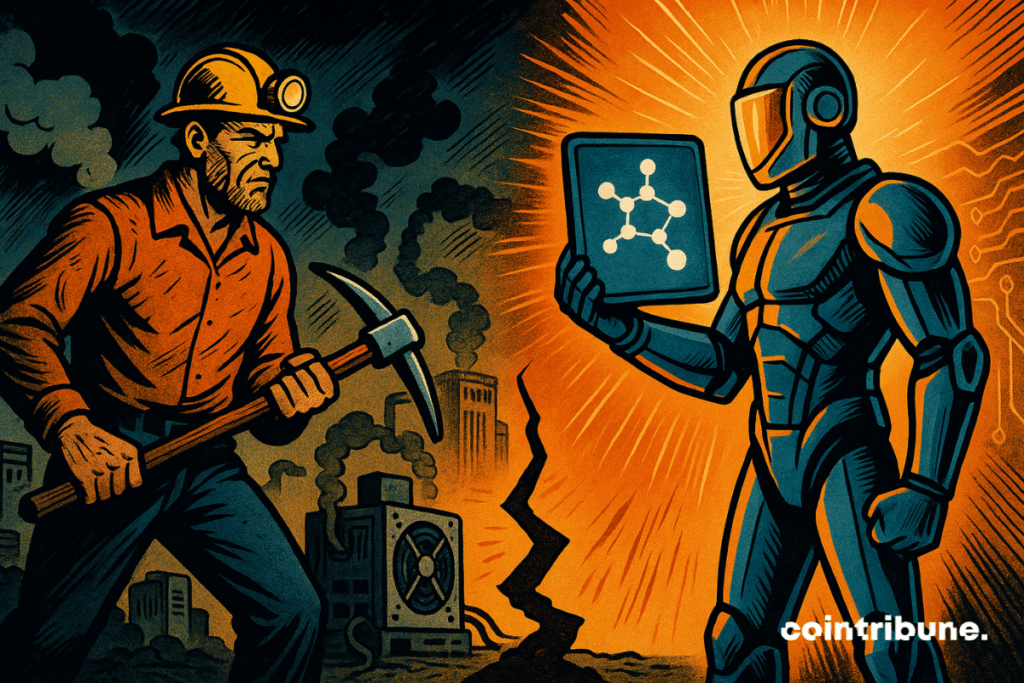What is Useful Proof-of-Work (UPOW)?
Fifteen years ago, Bitcoin introduced Proof-of-Work (PoW): miners burned electricity solving mathematical puzzles; the fastest won new coins and, by extension, secured the ledger. It was brilliant, but the world has changed. Energy prices are rising, regulators monitor carbon footprints as much as blockchains, and AI labs complain about the lack of affordable computing power. In this context, the original PoW feels a bit like burning fuel to run an empty engine. Qubic offers a simple solution: since the electricity bill is already paid, let’s use that energy for tasks useful to society. The Useful Proof-of-Work (uPoW) still protects the chain, but miners earn their living by training AI models and merge-mining Monero with real value, then directly reinject the earnings into the Qubic economy.

In brief
- Useful, not wasted: Qubic miners train AI models and merge-mine Monero while securing the chain, without useless hash computations.
- Cash flow loop: Earnings in XMR → swap to USDT → buy & burn $QUBIC → miners are paid, token supply decreases.
- Accessible hardware: Any modern multi-core CPU works; no ASIC wars, reduced energy footprint.
- Modular future: Any provable computation task (protein folding, 3D rendering, weather) can be integrated into uPoW.
The big idea in one table
| Classic Proof-of-Work (Bitcoin model) | Qubic Useful Proof-of-Work | |
|---|---|---|
| Main task | Guess a winning hash (no external utility) | Train AI models and mine Monero |
| Value created off-chain? | None | Yes – AI improvements & XMR coins |
| How miners are paid | New native tokens issued (inflation) | External XMR → swap to USDT → buy QUBIC → burn |
| Impact on supply | Expands (new coins created each block) | Contracts (automatic buy & burn each epoch) |
| Required hardware | Powerful ASICs or GPUs | Any modern multi-core CPU (laptop compatible) |
| Environmental narrative | “Energy cost for security” | “Energy cost + useful computation” |
How it works (story first, technical later)
Time in Qubic is divided into week-long epochs. Thousands of miners group into informal teams around candidates called Computors. All week long, these teams share their CPU cores between two tasks:
- Train neural networks – improve image or language models.
- Run RandomX – Monero’s CPU-friendly mining algorithm.
Both tasks produce chain-verifiable scores, serving as cryptographic proof. At the end of the epoch, the top 676 Computors access validator seats for the next round and share rewards.
The clever financial mechanism
- Teams’ Monero earnings are deposited into a contract.
- The contract swaps XMR for USDT, then uses this stablecoin to buy QUBIC on the market.
- The purchased QUBIC is burned on-chain, permanently reducing supply.
Security, miners’ income, and deflation all come from the same electricity source.
A week in the life of a new miner
Meet Alice, a student with a mid-range Ryzen laptop. She installs the open-source miner Qli Pool, limits CPU usage to 60% to keep her computer responsive, then forgets about it. Her free cores work: 60% training an image recognition model, 40% hashing RandomX for Monero.
Monday morning, the epoch ends. Alice’s team ranks 404th, a respectable score for a first week. Instantly, an on-chain routine converts her share of XMR to USDT, buys QUBIC, and burns it. Her wallet rings: +X QUBIC. The block explorer shows a total supply reduced by the same amount. No spreadsheets, no fee anxiety: just plug-and-earn while finishing her classes.
Why beginners should care
- Useful energy – Every kilowatt brings value: smarter AI or new XMR, no empty hashes.
- Ecological view – Regulators prefer “productive computation” over simple security costs.
- Built-in scarcity – Constant buy & burn benefits holders instead of dilution.
- Accessible hardware – A three-year-old laptop really works; no ASIC war needed.
- Scalable design – Any task providing verifiable proof (protein folding, CGI rendering, weather) can later be integrated into uPoW.
Need help? The Discord server answers newcomers’ questions within minutes.
Final thought
Bitcoin proved that energy can buy decentralized security. Qubic demonstrates that the same energy can buy security and something useful for the outside world. Whether that utility is better AI, Monero maintenance, or future breakthroughs, the principle is clear: every CPU cycle must count double. For beginners, that means learning crypto, supporting live AI tasks, and participating in a deflationary economy with hardware you already own.

Maximize your Cointribune experience with our "Read to Earn" program! For every article you read, earn points and access exclusive rewards. Sign up now and start earning benefits.
The Cointribune editorial team unites its voices to address topics related to cryptocurrencies, investment, the metaverse, and NFTs, while striving to answer your questions as best as possible.
The contents and products mentioned on this page are in no way approved by Cointribune and should not be interpreted as falling under its responsibility.
Cointribune strives to communicate all useful information to readers, but cannot guarantee its accuracy and completeness. We invite readers to do their research before taking any action related to the company and to take full responsibility for their decisions. This article should not be considered as investment advice, an offer, or an invitation to purchase any products or services.
Investment in digital financial assets carries risks.
Read more